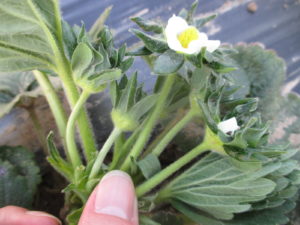Warm temperatures this week greatly encouraged strawberry growth and development. Some of the early cultivars may have entered the open blossom stage especially if they are grown with the annual plasticulture system in southern Indiana. Open flowers cannot tolerate temperatures lower than 30°F, while popcorn stage flowers (Figure 1) and tight buds may tolerant temperatures low to 26 and 22°F, respectively, according to information from Barclay Poling from NCSU. Lower than threshold temperatures may completely kill flowers or damage flowers that lead to misshaped fruit. Depending on the crop stages, this may result in devastating yield losses and/or delay the start of harvest season.
According to USDA Midwest Climate Hub briefing, warm temperatures this week will be followed by several days of freezing chances this weekend into early next week, and cold is likely through mid-April at least. The current forecast in southern Indiana predicts low temperatures that are in the mid 30’s for a few nights. It is important to note that even when air temperatures are forecasted to be in the upper 30’s at the weather shelter height (5 ft), it is still possible to have a killing frost at the strawberry canopy level.
When is it necessary for strawberry growers in southern Indiana to apply cold protection? Evaluating crop stage is extremely important. Growers may randomly pick 20 plants, calculate the average number of emerged flower buds/plant, popcorn stage blossoms/plant, and open blossoms/plant. If there are no open blossoms, growers in southern Indiana may not need to apply cold protection assuming predicted low temperatures stay in the mid 30’s. With 2-3 open blossoms per plant, growers may weigh the economic benefit of applying cold protection. Assuming strawberries are 20 grams each, if there are 15,000 plants/acre, loss 2-3 blossoms per plant may result in yield loss of about 1,600 lb/acre. Growers need to judge whether the yield loss is acceptable. If the plants are in the main blooming period, with more than 10 open blossoms per plant, there may be a risk of losing more than 60% yield without cold protection in the coming days. In northern Indiana, although it may still be early for strawberries to enter the open blossom stage, with predicted temperatures in the 20s, cold protection for emerging flowers is needed.
Hopefully, strawberry growers already have sprinkler irrigation set up or have middle to heavy row covers (1 to 2 oz/sq) handy for cold protection. Overhead sprinkler irrigation is the most effective for frost/freeze protection of developing and open blossom. But it can be risky if wind speed is more than 10 mph. Row covers can also provide 3 to 4 degrees of cold protection but they have to be pulled back in the morning following a night of cold protection as flowers need to be pollinated.
